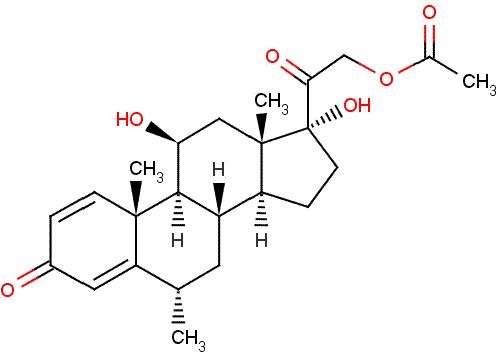Hybrisil
Generic name: methylpremethylprednisolone acetate
Dosage form: gel
Drug class:Topical steroids
Medically reviewed by Drugs.com. Last updated on Mar 22, 2022.
Disclaimer: This drug has not been found by FDA to be safe and effective, and this labeling has not been approved by FDA. Read further information about unapproved drugs.
On This Page
Hybrisil Description
DESCRIPTION: The topical corticosteroids constitute a class of primary synthetic steroids used as anti-inflammatory and anti-pruritic agents. Hybrisil™ Topical Silicone Gel contains methylpremethylprednisolone acetate, USP (CAS 53-36-1)
Chemical Name: Pregna-1,4-diene-3,20-dione, 21-(acetyloxy)-11,17-dihydroxy-6-methyl-,(6α,11ß)-,11ß,17,21-Trihydroxy-6α-methylpregna-1,4-diene-3,20-dione 21-acetate. It has a molecular formula of C24H32O6 and a molecular weight of 416.51.

Contains: Methylpremethylprednisolone acetate 1.0% in a base of: silicone cross-polymers, alcohol, cyclomethicones, propylene glycol, PEG-12 glyceryl dimyristate, and benzyl alcohol.
Hybrisil - Clinical Pharmacology
Topical corticosteroids share anti-inflammatory, anti-pruritic and vasoconstrictive actions.The mechanism of anti-inflammatory activity of the topical corticosteroids is unclear. Various laboratory methods, including vasoconstriction assays are used to compare and predict potencies and or clinical efficacies of the topical corticosteroids. There is some evidence to suggest that a recognizable correlation exists between vasoconstrictive potency and therapeutic efficacy in man.
Pharmacokinetics
The extent of percutaneous absorption of topical corticosteroids is determined by many factors including the vehicle, the integrity of the epidermal barrier and the use of occlusive dressings.
Topical corticosteroids can be absorbed from normal intact skin. Inflammation and /or other diseases processes in the skin increase percutaneous absorption. Occlusive dressings substantially increase the percutaneous absorption of topical corticosteroids. Thus, occlusive dressings may be a valuable therapeutic adjunct for treatment of resistant dermatoses. (see DOSAGE AND ADMINISTRATION)
Once absorbed



